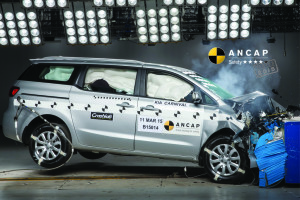
The prickly reaction by two New Zealand car companies to crash test findings by the Australasian New Car Assessment Programme (ANCAP) underlines partly why the facility will no longer be relevant once Australian carmakers shut down their manufacturing plants in 2017.
The two carmakers are BMW and Kia. Why are they upset? They are not saying, but word on the street and among dealers has it that it’s mostly because of the way the NZ Automobile Association reported the ANCAP results.
The Australian body scored the BMW 2-Series Active Tourer (top) four stars out of possible five, penalising it for leaving “the driver’s legs only marginally protected in a frontal offset crash test.” But ANCAP didn’t actually crash test the car, instead assessing under its own criteria a European-NCAP result, where the BMW scored a maximum five stars.
The AA’s general manager of road services, Stella Stocks, wrote of the BMW result: “While it’s encouraging to see manufacturers prioritising safety assist technologies, they need to remember that vehicle safety begins with a sound structure and ensure they are not compromising on driver and passenger safety through the body of the car.”
BMW is said to have been annoyed because there was no mention in the AA report of the four star/five star variation between the Australian and European crash findings, especially in light of ANCAP confirming it would no longer crash test cars after 2017 and would instead use Euro-NCAP ratings.
The carmaker’s NZ corporate communications manager Ed Finn would say only: “We have complete confidence in the Euro-NCAP safety rating results and would remind new car buyers that the BMW 2-Series Active Tourer is rated as a five-star Euro-NCAP car.”

ANCAP did crash test the Kia Carnival people-mover, giving it a four-star rating by failing it on frontal occupant protection. It said of the Kia: “There is heightened risk of serious injury to the legs and feet of the driver.”
Stocks wrote of the test result: “The Carnival is designed to be a family car, but doesn’t offer the best family protection. In a crash, both front occupants face the potential of serious injury.”
Stocks’ summation is apparently what got up Kia’s nose, that she said there was the potential of serious injury to “both front occupants” in the Carnival. The ANCAP reports only of serious injury to “the legs and feet of the driver.” Euro-NCAP is yet to test the Carnival.
Kia apparently voiced its disaproval by withdrawing at the last minute the AA’s invitation to the recent launch of the Kia Sorrento SUV. Kia Motors NZ general manager Todd McDonald refused to discuss the AA’s report of the Carnival’s crash test result or the reported AA snub.
The AA subsidises ANCAP. So does the NZ Transport Agency. Together they contribute upwards of $200,000 a year. Together they believe there is a role for ANCAP beyond 2017, when Australia’s car manufactures – Holden, Ford, Toyota – close down.
But the NZ Motoring Industry Association – the distributors’ representative – disagrees with the AA and NZTA. It, like most car companies in a recent poll in Australia, doesn’t believe ANCAP has a future.
Indeed, from January 2018, ANCAP will no longer crash test new vehicles. It will rely on Euro-NCAP ratings. Also, it does not have Australian Government funding beyond that date.
